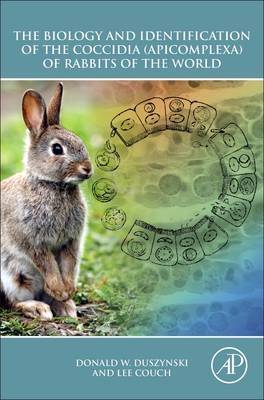
The Biology and Identification of the Coccidia (Apicomplexa) of Rabbits of the World
Elsevier Science Publishing Co Inc (Verlag)
978-0-12-397899-8 (ISBN)
The Biology and Identification of the Coccidia (Apicomplexa) of Rabbits of the World is a taxonomic summation of a damaging intestinal parasite found in rabbits and transmissible to other species, including humans. This book conceptually and historically summarizes the world's literature on the parasite and also provides a quick guide to isolation procedures, identification, strategies for management, and available chemotherapy. It is a vital source of knowledge about coccidia’s real and potential transmission to humans, which can lead to dangerous health problems, like severe dehydration, vomiting, lethargy and even death.
Coccidiosis is an intestinal disease that affects several different animal species, including canines and humans, and is one of the most prevalent protozoal infections in North America. The causative agent is a protozoan that has the ability to multiply rapidly and cause major damage in the intestinal wall, rupturing the cells of the intestinal lining. The final stage, the oocyst, is extremely resistant to environmental stress and is difficult to completely remove from the environment. Oocysts are frequent contaminants of feed and water and when the sporulated oocysts are ingested by other animals, they start the life cycle over in the new host. With the demand for rabbits in scientific research and for rabbit meat for human consumption increasingly globally each year, rabbits are of epidemiologic significance for laboratory workers, university researchers, veterinarians, pet owners, and breeders.
Dr. Duszynski, is Professor Emeritus Biology and past Chair of the Department of Biology, The University of New Mexico (UNM). He spent 33 years in academia, publishing numerous articles, monographs, and books, secured private, state and federal grants exceeding $8 million, and mentored > 25 masters and doctoral students and numerous undergraduates in his laboratory, before spending 8 years in administration. During his 41 year tenure at UNM, he taught many courses including parasitology, tropical biology and marine invertebrate biology, and took >1000 students to the neotropics (Belize, Jamaica, Mexico). Don has been a Visiting Research Associate Professor, Department of Physiology & Biochemistry, University of Texas Health Science Center, Houston, a Visiting Associate Professor, Department of Microbiology, University of Texas Medical Branch, Galveston, and Visiting Research Scholar, Kyoto University, Japan. Among the honors received are the Distinguished Service Award and the Clark P. Read Mentor Award from the American Society of Parasitologists (ASP), and the Distinguished Alumnus Award from the Department of Biology, Colorado State University. Lee Couch is Principal Lecturer of Biology, also at the University of New Mexico (UNM). She has taught Introductory Biology, Microbiology, Parasitology, and Tropical Biology. Lee also is the Coordinator of the Microbiology Culture Center and Microbiology Labs for the Deptartment of Biology at UNM and focuses her teaching on Microbiology for the Health Sciences. She is the author of two lab manuals: Biology for the Health Sciences and Microbiology for the Health Sciences. She is a past president of the Southwestern Association of Parasitologists and was the Chair for the American Society of Parasitologists Education Committee for 5 years. Her current research interests are in the analysis of the parasite loads of various species of wild animals from Africa, Japan, Europe, Russia, Alaska and Central and South America. In addition, Lee is a Volunteer Firefighter and Nationally Registered Advanced EMT (NRAEMT) working for her local Sandoval County Fire Department and the NM Medical Reserve Corps.
Chapter One: IntroductionChapter Two: Lagomorpha Origins and Diversification Chapter Three: Coccidia (Eimeriidae) of the Family Ochotonidae: Genus OchotonaChapter Four: Coccidia (Eimeriidae) from the Family Leporidae: Genus BrachylagusChapter Five: Coccidia (Eimeriidae) from the Family Leporidae: Genus LepusChapter Six: Coccidia (Eimeriidae) from the Family Leporidae: Genus OryctolagusChapter Seven: Coccidia (Eimeriidae) from the Family Leporidae: Genus Sylvilagus Chapter Eight: Sarcocystidae Poche, 1913, the Predator-Prey Coccidia in Rabbits: Besnoitia, Sarcocystis, ToxoplasmaChapter Nine: Cryptosporidium and Cryptosporidiosis in RabbitsChapter Ten: Strategies for Management and Therapy Chapter Eleven: Summary and ConclusionsGlossaryIndex
| Erscheint lt. Verlag | 5.8.2013 |
|---|---|
| Sprache | englisch |
| Maße | 191 x 235 mm |
| Gewicht | 880 g |
| Themenwelt | Naturwissenschaften ► Biologie ► Mikrobiologie / Immunologie |
| Naturwissenschaften ► Biologie ► Zoologie | |
| ISBN-10 | 0-12-397899-8 / 0123978998 |
| ISBN-13 | 978-0-12-397899-8 / 9780123978998 |
| Zustand | Neuware |
| Haben Sie eine Frage zum Produkt? |
aus dem Bereich


